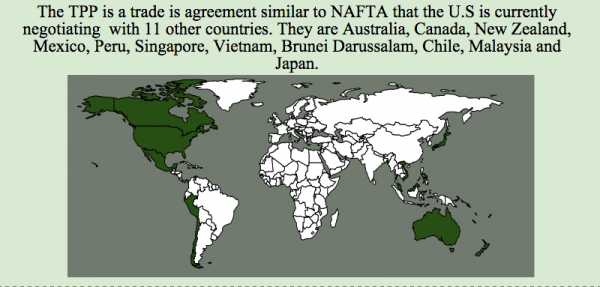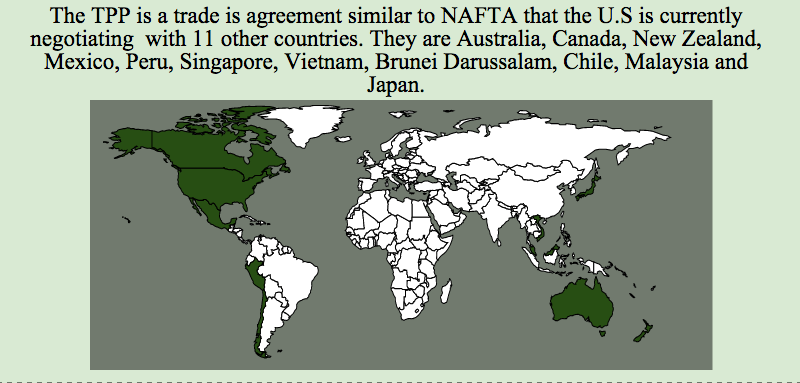EL PASO — Clouded in secrecy, the United States is negotiating a trade agreement with 11 other countries throughout the Asia-Pacific region, including Mexico, known as the Trans Pacific Partnership (TTP).

PiktoChart graphic by Maria Esquinca
TPP has been compared to the North American Free Trade Agreement (NAFTA), a trade agreement between Mexico, the U.S, and Canada that was signed by President Bill Clinton in 1993 and came into effect in 1994. Critics of TPP have referred to it as NAFTA on steroids.
The other countries involved in the agreement are Australia, Canada, New Zealand, Peru, Singapore, Vietnam, Brunei Darussalam, Chile, Malaysia and Japan.
Negotiations for the treaty have been conducted behind closed doors with no public or congressional input.
“It’s still being negotiated; the concerns I have though- are that congress has not been actively engaged in the negotiating process,” said U.S. Congressman Beto O’Rourke, D-Texas. “I do think the relevant committees of jurisdiction should have a role to play.”
So far, 605 corporate advisors have been allowed to access the TPP text. However, despite the secrecy, some chapters of the proposal have been leaked online.
“What we need is greater transparency and greater accountability,” said Howard Pearlmutter, a consultant with Solar CIO, a company that provides strategic planning on emerging solar energy technologies. Some of its clients have included Apple, EPA, and the El Paso Solar Energy Association.
“The TPP is a trade deal, kind of like NAFTA, that creates a trade area to create a free trade area to reduce the tariffs … and increase the amount of trade in a particular area,” said Pearlmutter.
NAFTA eliminated tariffs in the agricultural, manufacturing and services. It also removed investment restrictions and added protections to intellectual property.

PiktoChart graphic by Maria Esquinca
According to NAFTANOW.org, since the trade agreement went into effect trade among the three countries has tripled. The North American economy has more than doubled in size and North American employment levels have climbed nearly 23% since 1993, representing a net gain of 39.7 million jobs.
The Peterson Institute of Economics estimates the TPP will generate $78 billion per year in the U.S, and global annual incomes of $295 billion.
“It certainly has the potential to improve economic development and job opportunities,” said O’Rourke. “This could enhance or improve our agreement with Mexico, it could do more to ensure better labor conditions, it could do more to ensure environmental protections, and there are a lot of potential positives in TPP.”
Patrick Schaefer, executive director of the Hunt Institute for Global Competitiveness, a regional economic think tank, says that it is misleading to call these agreements free trade pacts because free trade generally means trade in either goods or services, “… but NAFTA, for example, also includes a foreign investment provision to protect foreign investment.”
And, critics of TPP are worried about the protections for foreign investment included in the partnership, among other things.
Similar to NAFTA, TPP has an international arbitration provision that would protect foreign investors. Under this provision a foreign investor can file a claim against the country it’s investing in, if it loses expected profits due to health, labor, and environmental laws.
“That treaty or that trade agreement provides that foreign investor protections, meaning it restricts the government from taking certain actions with respect to that investment,” said Schaefer. “If the government contravenes those protections … the private investor can file a claim. This claim will be adjudicated by international tribunal, not a domestic court, not with domestic law.”
According to Schaefer, the international tribunal would be composed of a member from the responding state and the claiming individual, and a third member chosen by the two other members of the tribunal.
“People get really freaked out about that,” said Schaefer. “In NAFTA there’s been a healthy amount of international tribunals that have been convened by a private investor filing a claim against a state government.”
An example of a claim being filed by a foreign investor under NAFTA occurred in Canada. The country was sued for $250 million by U.S. based, Ethyl Corporation, after Canada had banned a gasoline additive known as methylcyclopentadienyl manganese tricarbonyl (MMT), due to health risks.
Ethyl argued that the Canadian government violated NAFTA because it resulted in loss of future profits and it ruined the company’s reputation. After Canada realized the international tribunal would likely vote in favor of Ethyl, the Canadian government ended up revoking the ban, paid Ethyl $13 million for lost profits, and issued a public statement declaring there was no evidence MMT posed health or environmental risks.
“With any kind of trade, there’s always parties to the trade that have a significant advantage. The trade is never equal, depends on who has the most to offer and who has the most to gain, said Richard Gutierrez, associate professor of political science at the University of Texas at El Paso. “The primary group that pushes for free trade is large corporations.”
If signed, all countries would have to conform their domestic laws to the agreement of the partnership.
“It would standardize those agreements among all the countries,” said O’Rourke. “In that harmonization process some aspects of our agreements with Canada and Mexico in NAFTA, would change to ensure that they’re consistent with whatever is negotiated in the TPP.”
Concerns by critics of TPP encompass areas of environmental laws, labor laws and intellectual property.
“If this agreement allows products to be manufactured in a country that has very low environmental standards, and yet they can come into the consumer oriented countries like the U.S inexpensively, then the net effect is it’s going to make it harder for producers in the United States to compete,” said Pearlmutter.
According to environmental advocates the partnership would undermine environmental laws and regulations by stopping governments who are implementing localized green manufacturing, because they could violate the agreements between all partnering countries.
“It would make it so that the treaty overrules the law of the country and the states within those countries, for that reason alone it is absolutely unacceptable,” said Pearlmutter. “There is this problem of sovereignty, that the treaty would overrule national sovereignty.”
Others, like Schaefer are concerned that there has been little input in the negotiation process in places will TPP have the greatest impact, such as the El Paso Del Norte region.
“Our lives here are completely and utterly wrapped up in the dynamics that are born out of NAFTA… That’s the same thing that is happening with TPP,” said Schaefer. “There’s often not much explicit discussion of how we- the El Paso Del Norte region, fits into that. We lose an opportunity to influence those agreements to our advantage.”
O’Rourke said he also shares many of the concerns others have about TPP and he will be considering them once congress is presented with a legislation regarding the partnership.
“I will be thinking about those issues when I look at the final text of any TPP agreement that is brought to congress,” said O’Rourke during the latter part of the 113th Congress in 2014. “We don’t have a date when that might happen…There was some talk that it was going to be presented as far back as October of 2013, its certainly not going to happen in this congress.”

